What you need to know about the new Galaxy Note 20 and Note 20 Ultra
Both pack 5G and Qualcomm's fastest chips, but one looks a lot better on paper.
Never let it be said that Samsung doesn't shake things up. Last year it gave us two Galaxy Notes for the first time since 2014. (Remember the Note 4 and Note Edge? Those were the days.) Just a few months ago, Samsung revealed a trio of new Galaxy S phones, including an oversized model that waltzed into the Galaxy Note's corner of the market. Which has left the top-end of the company's lineup feeling awfully crowded.
And the crowd just got bigger. Samsung officially revealed the Galaxy Note 20 ($999) and Note 20 Ultra ($1,299) today, alongside a slew of other new devices at its online-only Unpacked event. The big question now is whether these two Notes can carve out niches for themselves among Samsung's already-huge pack of premium devices. And, honestly, I’m not so sure about that.
The Ultra experience
Over the years, the Galaxy Note line has become more or less synonymous with big screens, powerful processors, and, of course, the S Pen. Both the Galaxy Note 20 and the Note 20 Ultra pack all of the above, but between the two, the Ultra caters more to Samsung's most demanding fans.
First things first: With its 6.9-inch Dynamic AMOLED 2X display, the Note 20 Ultra is a big phone. For those keeping count, that's the same size as the Galaxy S20 Ultra's display, and both of these screens refresh at up to 120Hz. Just like last year's Note, there's a tiny hole punched out of the top of the screen to accommodate a 10-megapixel front-facing camera, and the lack of bezels around the display once again means you'll have plenty of real estate for jotting down notes during your (remote) meetings. The screen's tall aspect ratio also makes the Ultra a little narrower and easier to handle than you might suspect, though folks with big mitts are still Samsung’s real audience here. (Even I had trouble one-handing it.) Unlike last year, there is no version of the Note for people with smaller hands, which honestly feels like a mistake.
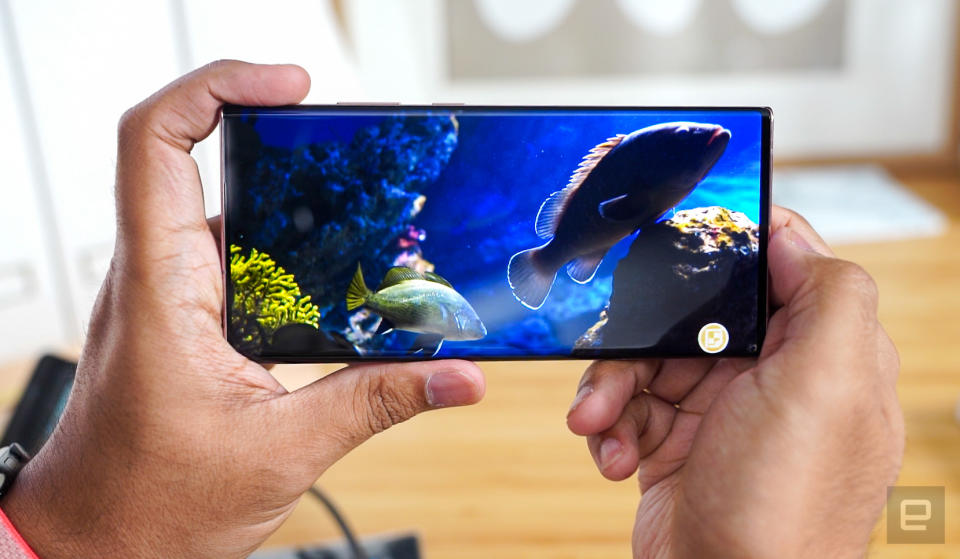
Speaking of big, the Note 20 Ultra's camera array looks (and feels) absolutely enormous. From what I can tell, it's very similar in size to the Galaxy S20 Ultra's hump, but it really stands out thanks to the new, bronze finish Samsung is pushing this year. What's inside, however, should sound pretty familiar. Samsung's 108-megapixel main camera is back and seemingly identical to the one found in the S20 Ultra -- ditto for the 12-megapixel ultra-wide, which still captures a 120-degree field of view.
That's not to say Samsung hasn't tweaked its formula, though. This time it opted for a 12-megapixel telephoto camera, and while that doesn't sound nearly as impressive as the S20 Ultra's 48-megapixel sensor, the Note 20 Ultra's long-range shooter has a slightly wider aperture which should help in low light. Samsung's crazy Space Zoom feature is back too, though it's been neutered a little. The Note 20 Ultra can push in 50x, compared to the 100x on the S20 Ultra. Frankly, this is fine. In addition to being creepy, those 100x photos looked downright terrible most of the time.
Based on its name and those oh-so-similar cameras, it would be easy to assume that not much has changed internally from the Galaxy S20 Ultra. That's not exactly the case. Inside is one of Qualcomm's Snapdragon 865+ chipsets, and since its CPU cores are clocked slightly higher than the standard 865's, the Note 20 Ultra should have a slight edge when it comes to horsepower. Of course, considering just how fast the standard Snapdragon 865 was, I suspect most people would be hard-pressed to spot any meaningful differences in performance. (I certainly didn’t.) That's especially true because, like the S20 Ultra, all versions of the Note 20 Ultra pack 12GB of RAM -- apart from the color, the only choice you'll have to make is whether you want 128GB ($1,300) or 512GB of storage ($1,449).
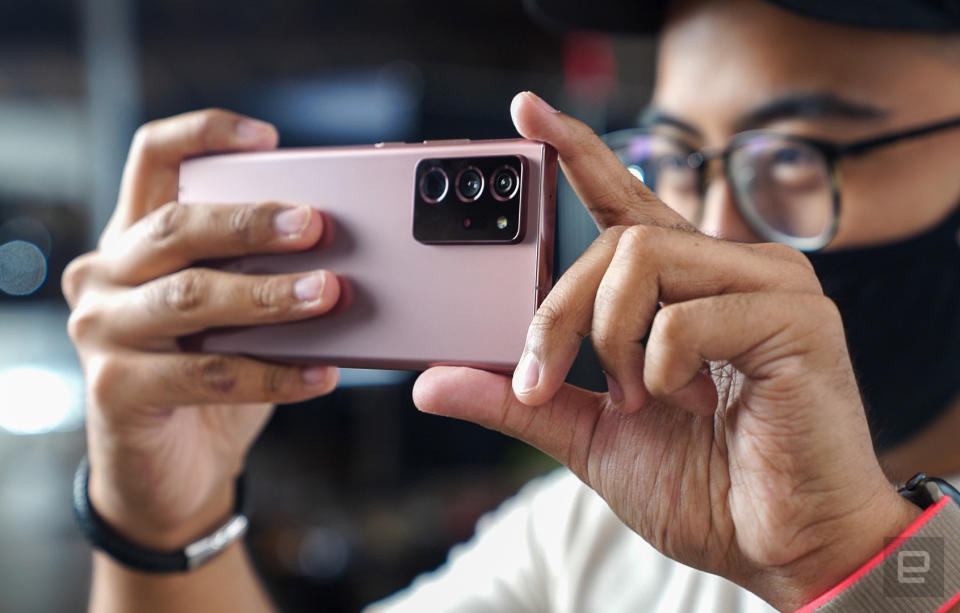
A few other things to note: The Note 20 Ultra has a 4,500mAh battery, which is notably smaller than the S20 Ultra's. (Samsung swears that the two phones are rated for the same longevity, but we'll be the judge of that.) Long-time Note fans will also have to reset their muscle memory since the Bluetooth-enabled S Pen now slots in on the bottom-left corner. I can already imagine myself thumbing for the stylus where it used to be, and I'm getting frustrated. That said, actually using the S Pen should feel a little more natural than it used to. Thanks to some software improvements and the S20 Ultra’s fancy new screen, the delay between writing something on this glass and seeing it appear is minimal -- think about nine milliseconds. Seeing Samsung demonstrate this minimal latency in person has made me wonder if it might finally be time to give writing on glass another try.
The Note 20 Ultra is also the first Samsung device to pack an ultra-wideband (or UWB) radio for short-range data transmission. UWB has plenty of applications, but it’s perhaps most widely known in smartphone circles as the technology that allows Apple’s iPhone 11 series to AirDrop files by pointing one device at another. Samsung told us that the Note 20 Ultra will include a similar feature so you can quickly move files from one Ultra to another, and before long the company plans to use the radio to locate Samsung devices with AR and unlock doors.
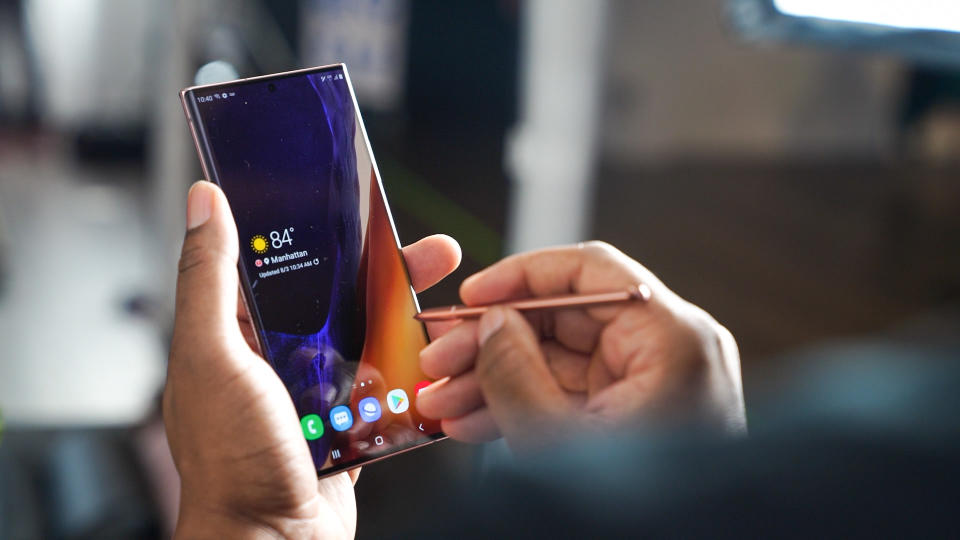
New year, new tricks
If the Note 20 Ultra seems like an S20 Ultra with a stylus and a bit of a makeover, that’s not surprising. The overlap here is considerable, and more than a little concerning.
Let's run through the software additions that help define the Note 20 experience. And naturally, we need to start with the S Pen. All of the classic features are here -- check out our Note 10+ review for a closer look at them -- but now you can navigate the Note's interface with swishes and flicks of your wrist. Imagine drawing specific kinds of zig-zags in the air will reveal your recent apps, go back one level, bring you back to the home screen, and even grab a screenshot. These gestures are much more angular than the ones that debuted on last year's Note 10, and that should theoretically make them a little easier to pull off. Emphasis on "theoretically” -- from what I’ve seen, it still takes some practice to get them working just right.
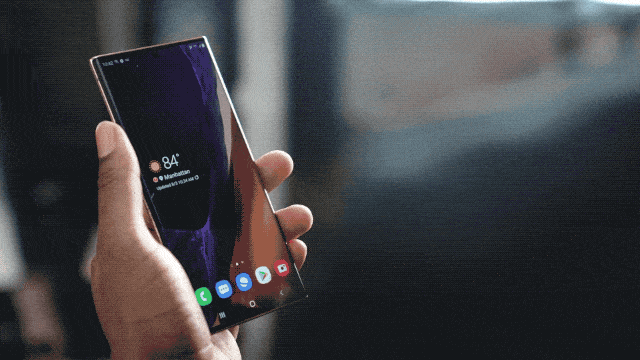
Adding new Air Actions like these was inevitable, and the idea of navigating your phone with a magic wand of sorts is ambitious enough to be charming. Still, how often will you actually need to multitask on your phone when you're not holding it? Even for avid stylus fans, I suspect the answer is "rarely." Thankfully, some of Samsung's other S Pen-centric features are a little more practical. You'll finally be able to mark up PDFs in the built-in Notes app, and if you're the sort who likes recording meetings or classes while jotting down bullet points, you can tap specific scribbles on-screen to jump to different parts of the audio file. Honestly, where was this when I was in college?
Samsung also seems quite proud of its new wireless DeX feature, which will let you "cast" a desktop-like interface to any Miracast-enabled display. (Naturally, that includes all Samsung Smart TVs from 2019 onward.) But, Samsung hasn't explained the feature in-depth yet, so it's anyone's guess how helpful it'll really be.
The Note series has always had a reputation as being solid workhorses, and that continues with improved Link to Windows support and a feature that immediately syncs your notes or sketches to the cloud. Turns out, Samsung's embrace of the cloud also extends to a new gaming deal with Microsoft -- starting on September 15th, Note 20 owners will be able to stream games through Xbox Game Pass Ultimate. Of course, how well any of this stuff actually works is still up in the air. Samsung has yet to show off a Note 20 Ultra with feature-complete software, so we'll have to hold off on evaluating -- well, any of these new additions.
All in all, though, the Note 20 Ultra is just what we expected. It's a giant phone with an S Pen and an aversion to most kinds of compromise. There’s a problem with that approach, though. Even with its many tweaks and clever refinements, the Note 20 Ultra doesn't feel all that distinct now that devices like the Galaxy S20 Ultra are making headlines. That's especially disappointing when you consider the Note series was always meant to represent Samsung at its most ambitious. People have argued that the Galaxy Note is less relevant now that there's a super-premium Galaxy S device in the mix, and I'm starting to agree -- the Ultra probably won't make you a Note believer if you weren't one already.
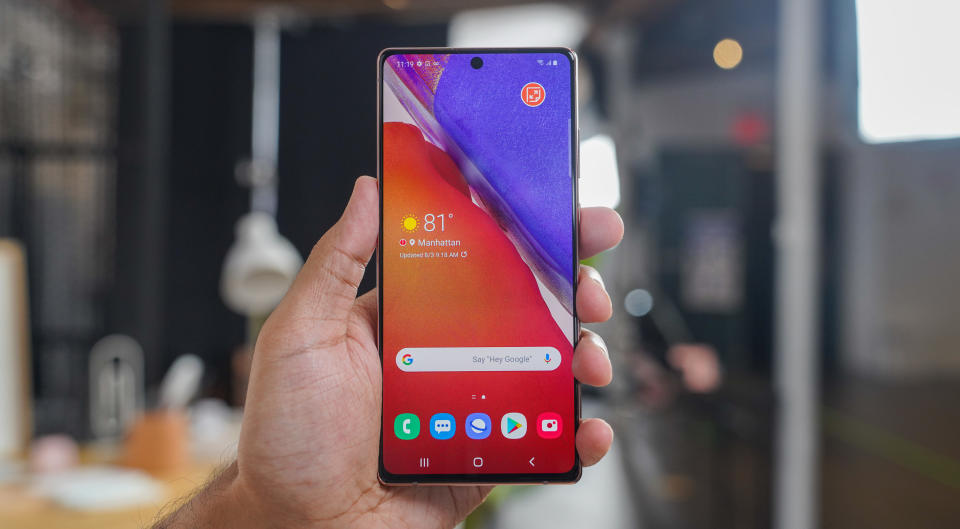
Puzzling compromises
Then there's the Galaxy Note 20, which feels alarmingly unfocused for a $1,000 smartphone. Consider last year's Galaxy Note 10: It was largely the same phone as the Note 10 Plus, just smaller. Despite what industry trends might suggest, not everyone wants a chonker in their pocket or purse. Because of that, the Note 10 was a fine choice for people who'd been sized out of earlier models. This year's Note 20 is also very similar to the Note 20 Ultra, except it’s not significantly smaller and it’s a little worse in most ways.
All the software tricks I just mentioned are present here too, but the hardware is considerably less impressive. The Note 20 has a 6.7-inch screen so it's technically smaller, but honestly -- the difference in size is barely noticeable. Unlike the standard Note 10, the Note 20 is not a phone for people with small hands. That screen? It runs at a lower, 2400x1080 resolution and only refreshes at 60Hz. The Note 20’s S Pen doesn’t have the same, super-low latency that the Ultra’s does, either. Granted, the S Pen still feels smoother and faster to respond here than it would on the Note 10, but Samsung’s choice of screen means Note 20 Ultra users still get the best experience.
The Note 20 also only comes with 8GB of RAM and 128GB of storage, and there's no expandable memory; that's only available on the Ultra. Granted, it still has a Snapdragon 865+ so sheer horsepower shouldn't be an issue, but the list of little downgrades just continues. Its back is made of what Samsung calls "glasstic," which we've seen before on the company's mid-range A-series phones. It's plastic that looks nearly indistinguishable from the Note 20 Ultra's rear glass, but feels more hollow and on the whole less durable. Not exactly what one likes to see on a phone with a four-figure price tag.
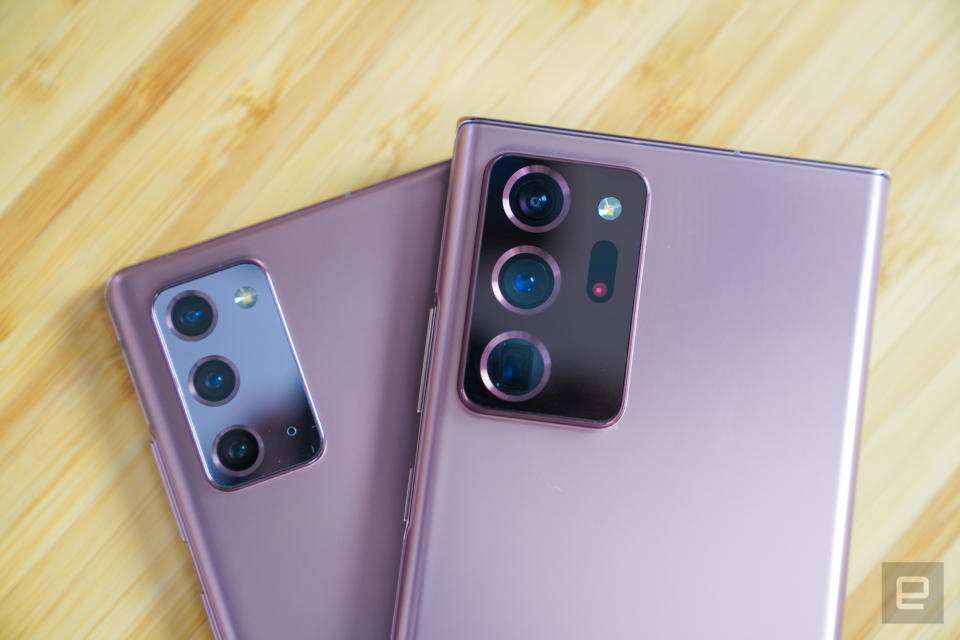
Its cameras are considerably tamer too, at least by Samsung standards. Rather than go all-out as it did with the Note 20 Ultra, Samsung appears to have just transferred the Galaxy S20 Plus's three main cameras into the Note 20. That's especially ironic since, as of this writing, recent deals and promos temporarily made the unlocked Galaxy S20 Plus with the same cameras, a better screen, expandable storage, more RAM and a slightly larger battery quite a bit cheaper than the Note 20.
Credit where it's due, this thing isn’t without its charms. For one, it has a slightly rounder body that I find surprisingly appealing, even as a fan of new Notes’ squarish aesthetic. The Note 20’s display is completely flat too, rather than slightly curved at the edges like the Ultra’s — that may make it less prone to accidental touches. And it still feels like a well-put-together device, even if it lacks the sheer style and reassuring density of its more expensive sibling.
I get what Samsung is trying to do here. This is a phone for people who want most of the Note experience but don't need all the premium frills, and that’s a valuable argument. The thing is, it’s still a $1,000 phone. When you consider many people (in the US anyway) buy expensive smartphones like these on installment plans anyway, it can be hard to imagine someone not shelling out a little per month for the Ultra. After all, that $1,300 behemoth is exactly the kind of phone Samsung has long believed — or argued, at least — its die-hard Note fans really want.
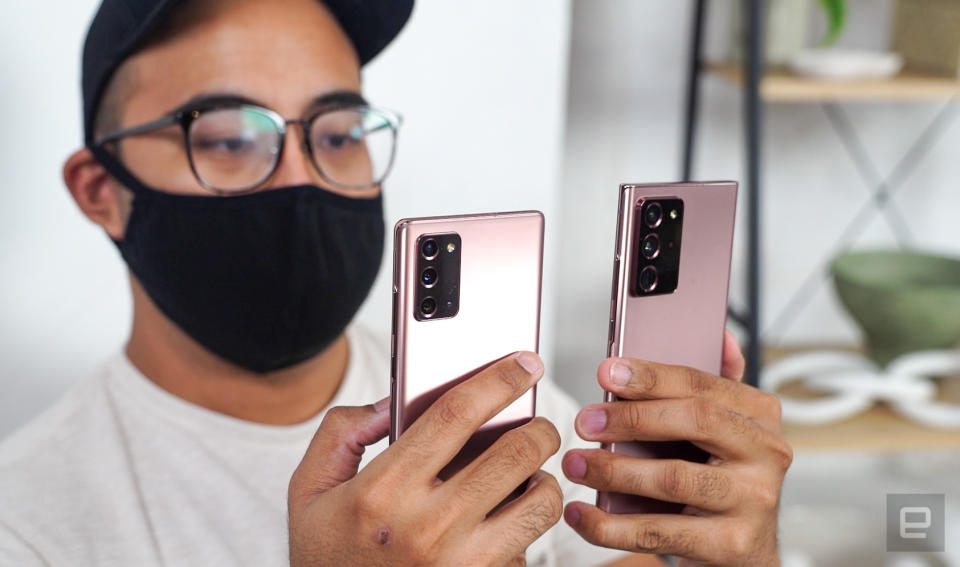
Beyond all that, Samsung has insisted for years that the Note series represented the peak of smartphone-making prowess. With the Note 20, the company is muddying that message. Maybe I'm wrong -- maybe the regular Note 20 will become the kind of mass-market hit Samsung really wants. For now, though, it largely comes off like a watered-down version of the Ultra with an asking price that makes it hard to overlook some notable compromises. To find out if that’s really the case, I'd suggest you stick around for our continuing coverage (and eventual review) before you decide to drop upwards of $1,000 on either one of these phones, but if you absolutely can't wait, pre-orders for both Notes kick off at midnight on August 6, 2020.
Pre-orders
You can “reserve” the Samsung Galaxy Note 20 and Note 20 Ultra today starting at $999 and $1,299, respectively. Pre-orders officially begin August 6, and you can pick up either smartphone at a physical retail location starting August 21. Those who pre-order either device should receive it by August 21 as well.
Samsung added a few perks for those who reserve or pre-order the Note 20 or the Note 20 Ultra. First, you can get up to $500 off if you have a device to trade in when you pre-order. You’ll also get a $150 Samsung credit that you can use towards accessories or the Xbox Game Pass Ultimate bundle that includes a Bluetooth gaming controller that you can use to stream and play Xbox games from your new phone. To top it off, you’ll also get four months of YouTube Premium for free and six months of Spotify Premium for free.
You also have the option to go to Best Buy for your Note 20 or Note 20 Ultra pre-order. Best Buy is offering up to $700 off if you have a qualifying device to trade in, and you’ll get a $150 Samsung credit as well.
Key specs
Galaxy Note 20 | Galaxy Note 10 Ultra | |
|---|---|---|
Pricing | $999 | $1,299/$1,449 |
Dimensions | 161.6 x 75.2 x 8.3 mm (6.36 x 2.96 x 0.33 inches) | 164.8 x 77.2 x 8.1mm (6.48 x 3.04 x 0.32 inches) |
Weight | 194g (6.84 ounces) | 208g (7.34 ounces) |
Screen size | 6.7 inches (170.2 mm) | 6.9 inches (175.3mm) |
Screen resolution | 2,400x1,080 (393 ppi) | 3088x1440 (496ppi) |
Screen type | Infinity-O Dynamic AMOLED, 60Hz refresh | Infinity-O Dynamic AMOLED 2X, 120Hz refresh |
Battery | 4,300 mAh | 4,500mAh |
Internal storage | 128 GB | 128GB/512GB |
External storage | None | microSD, up to 1TB |
Rear camera(s) | Three cameras: | Three cameras: 12MP Ultra-wide (f/2.2, PDAF,120° field of view), 108MP Wide (f/1.8, OIS), 12MP Telephoto (f/3.0, 5x optical zoom, 50x Space Zoom) |
Front camera(s) | 10MP, f/2.2 | 10MP, f/2.2 |
Video capture | Up to 8K at 24 fps | Up to 8K at 24 fps |
SoC | Qualcomm Snapdragon 865 Plus | Qualcomm Snapdragon 865 Plus |
CPU | 2.84 GHz octa-core | 2.84 GHz octa-core |
GPU | Adreno 650 | Adreno 650 |
RAM | 8 GB | 12GB |
WiFi | Dual band, 802.11ac/ax | Dual band, 802.11ac/ax |
5G | Yes, sub-6 and mmWave | Yes, sub-6 and mmWave |
Bluetooth | v5.0 | v5.0 |
Operating system | Android 10 | Android 10 |
Other features | IP68 certified, USB-C, WPC wireless charging, in-display fingerprint sensor | IP68 certified, USB-C, WPC wireless charging, in-display fingerprint sensor |

